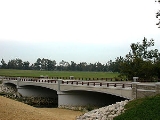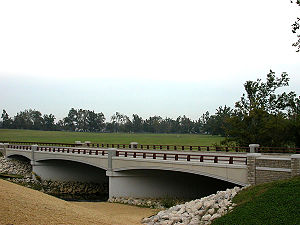
Paris Pike
Encyclopedia

U.S. Route 27
U.S. Route 27 is a north–south United States highway in the southern and midwestern United States. The southern terminus is at US 1 in Miami, Florida. The northern terminus is at Interstate 69 in Fort Wayne, Indiana...
/68
U.S. Route 68
U.S. Route 68 is an east–west United States highway that runs for from northwest Ohio to western Kentucky. The highway's western terminus is at U.S. Route 62 in Reidland, Kentucky. Its eastern terminus is at Interstate 75 in Findlay, Ohio...
between Paris
Paris, Kentucky
As of the census of 2000, there were 9,183 people, 3,857 households, and 2,487 families residing in the city. The population density was . There were 4,222 housing units at an average density of . The racial makeup of the city was 84.23% White, 12.71% African American, 0.16% Native American, 0.16%...
and Lexington
Lexington, Kentucky
Lexington is the second-largest city in Kentucky and the 63rd largest in the US. Known as the "Thoroughbred City" and the "Horse Capital of the World", it is located in the heart of Kentucky's Bluegrass region...
, Kentucky
Kentucky
The Commonwealth of Kentucky is a state located in the East Central United States of America. As classified by the United States Census Bureau, Kentucky is a Southern state, more specifically in the East South Central region. Kentucky is one of four U.S. states constituted as a commonwealth...
.
For years, this stretch of road had only two side-by-side lanes and no emergency breakdown lane. Given the large amount of auto and farm machinery traffic the road carried, plus the high number of fatalities from vehicular accidents, the Commonwealth of Kentucky Department of Transportation opted to add two more lanes.
In 1966, discussions were held about how best to widen the road. The original project razed historical structures and would mandate a four-lane divided highway with a 40 feet (12.2 m) uniform grassy median. Local citizens took the Transportation Cabinet to court to stop the plans.
In 1977, the Bluegrass Land and Nature Trust stepped in to help oppose the plans.
In 1979, an injunction was issued and the existing plans for widening were scrapped. The court issued a statement in that it wanted more considerate and careful alternatives that would preserve the highway's historic significance. In 1980, the Paris Pike widening project was cancelled. An injunction was issued.
In 1986, proponents and opponents of the Paris Pike widening project met, agreeing to work together in order to improve the safety and capacity of the deadly road. Fatalities up to that point were increasing every year, claiming, for instance, a family of five in 1985.
In 1990, Bluegrass Tomorrow created a committee of supporters and opponents of the Paris Pike project with hope that a compromise could be reached on how the roadway should be improved. Unfortunately, later that year the Kentucky Department of Transportation released their Record of Decision, in that the Paris Pike should be improved by widening the highway to four-lanes with a 40 feet (12.2 m) median, almost exactly like the plans in 1966 which were later cancelled.
In 1991, in order to reach a compromise, a Memorandum of Agreement that was coordinated with the state transportation cabinet, the Federal Highway Administration
Federal Highway Administration
The Federal Highway Administration is a division of the United States Department of Transportation that specializes in highway transportation. The agency's major activities are grouped into two "programs," the Federal-aid Highway Program and the Federal Lands Highway Program...
, the National Advisory Council on Historic Preservation, and the Kentucky State Historic Preservation Office in order to satisfy Section 106 of the National Historic Preservation Act.
The Memorandum of Agreement stated that several activities would need to occur before any design or construction on the Paris Pike would take place.
Later in 1991, the U.S. District Court turned down a request by federal and state officials to lift portions of a 1979 injunction and denied the state transportation cabinet from selecting a design task force. During this time, a proposal by then governor Brereton Jones
Brereton Jones
Brereton Chandler Jones is a horse breeder and politician from the US state of Kentucky. From 1987 to 1991, he served as lieutenant governor of Kentucky and from 1991 to 1995, he was the state's 58th governor...
was derailed as it would have utilized an abandoned railroad corridor to the east of the existing Paris Pike.
In 1992, the Paris Pike Committee was formed with representatives from Fayette and Bourbon counties and two preservation organizations. This new committee would later set specific guidelines regarding roadway design, land use, and preservation, stating that the new highway could be more beautiful than what currently existed. Later meetings extended those statements with a pact to preserve the land around the highway from development forever.
Several of those design specifications called for a four-lane highway with grass shoulders, and where possible, the existing roadway would be used. The highway would flow with the contours of the landscape, and the existing rock walls and entryways would be preserved. Other features that were mentioned included guardrail considerations and landscaping. The final report from the Paris Pike Committee was signed off in May 1993 and endorced by all preservation and conservation groups who at one point were at odds over this widening project.
The injunction was lifted in September 1993. Landscape architect
Landscape architect
A landscape architect is a person involved in the planning, design and sometimes direction of a landscape, garden, or distinct space. The professional practice is known as landscape architecture....
Grant Jones and his Seattle-based firm, working with engineering consultant H. W. Lochner, Inc. of Lexington, designed the new Paris Pike utilizing the criteria set forth by the Paris Pike Committee.
The widening project began in 1997 and the four-lane divided highway was completed in 2003. The total budget for the project was $69.9 million, however, it was completed at a cost of $93 million or $4.5 million per mile, 1.8 times the cost of a typical four-lane highway in the state.
As a result of the widening project, the level-of-service along the highway went from an overall grade of 'F' (failing) to 'A' (excellent) and became one of the most scenic byways in the nation. The desire by the designers of the highway, the general public, and the numerous preservation organizations to maintain the historic character of the corridor and to maintain its unique character made the cost extraordinairly high but it was well worth the cost. Dry-laid limestone rock fences were dismantled and reconstructed by hand, for instance, and extensive landscaping and tree planting using native species were utilized. As a result of this careful construction, the Paris Pike project won a 2002 Merit-Design award from the American Society of Landscape Architects as well as the 2003 Federal Highway Administration's Environmental Excellence Award and the National Partnership for Highway Quality 2003 State Award.
A horse named after Paris Pike won the Scottish Grand National
Scottish Grand National
The Scottish Grand National is a Grade 3 National Hunt steeplechase in Great Britain which is open to horses aged five years or older. It is run at Ayr, Scotland, over a distance of approximately 4 miles and 110 yards and 27 fences...
Steeplechase
Steeplechase
Steeplechase may refer to:* Steeplechase, an event in horse racing* SteepleChase, a Danish jazz label* Steeplechase , a 1975 arcade game released by Atari...
in 2001 before falling at the first fence in the famous 2002 Grand National
2002 Grand National
The 2002 Grand National was the 155th official renewal of the world-famous Grand National steeplechase that took place at Aintree near Liverpool, England, at 3:45pm BST on 6 April 2002....
at Aintree
Aintree
Aintree is a village and civil parish in the Metropolitan Borough of Sefton, Merseyside. It lies between Walton and Maghull on the A59 road, about north of Liverpool city centre, in North West England....
, England
England
England is a country that is part of the United Kingdom. It shares land borders with Scotland to the north and Wales to the west; the Irish Sea is to the north west, the Celtic Sea to the south west, with the North Sea to the east and the English Channel to the south separating it from continental...
.
Sources
- Landscape Architecture Foundation Publishes Case Study on Kentucky’s Paris-Lexington Road. Kentucky Transportation Cabinet. http://www.kytc.state.ky.us/news/11-26-03-2.htm
- Paris Pike Committee Report. Paris Pike Committee. 1993. 23 March 2004.
- "Technical Memorandum: Design Criteria, Paris Pike Reconstruction Project, Fayette and Bourbon Counties." Kentucky Transportation Cabinet. 1994. 23 March 2004.

